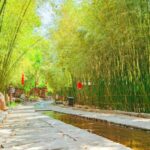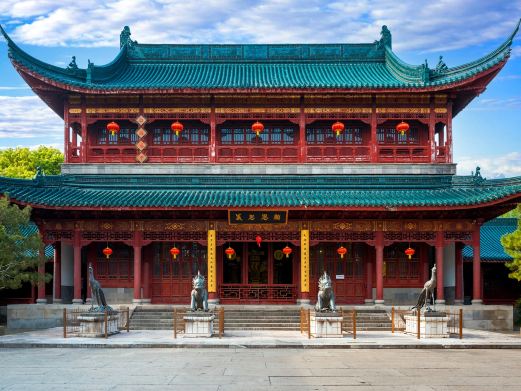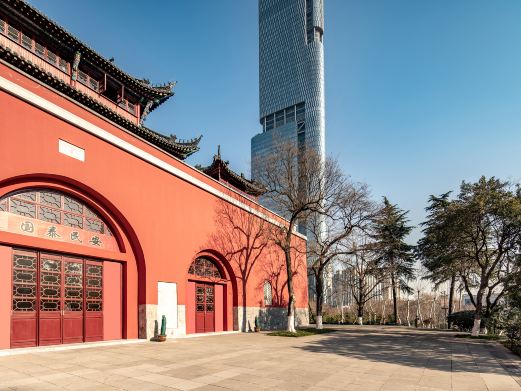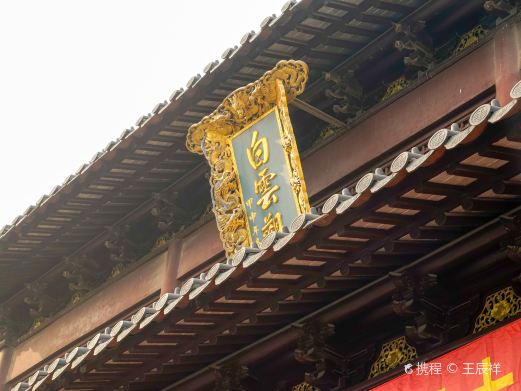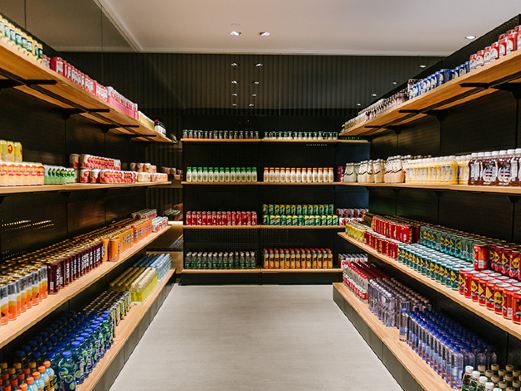The Xiangshan Scenic Area is located within the Zhangjiagang Free Trade Zone (Jingang Town). It is a national AAAA-level tourist scenic area. Since ancient times, Xiangshan has had beautiful scenery and numerous historical sites. It is rough yet beautiful, majestic yet elegant, and has long been reputed as a famous mountain in the south of the Yangtze River. Throughout history, countless celebrities have left many footprints on Xiangshan.
There are not only beautiful sceneries such as the Caixiang Path left by Xi Shi when she picked fragrant herbs, the Plum Blossom Hall inscribed by Su Dongpo himself, and the Peach Blossom Gully praised by Xu Xiake, but also new sceneries such as the Xiangshan Lake with a wide surface and water as clear as a mirror, and the ten thousand-plum ridge with ‘a thousand hectares of snow waves’. Together, they form a picturesque scroll of lakes and mountains, which is pleasing to the eye and makes people linger and forget to return. The Xiangshan History and Culture Exhibition Hall (opening hours are subject to scenic area announcements). The exhibition hall is located on the south side of the main entrance of Xiangshan. It集中展示了香山的山水风情和历史文化底蕴,是香山地区民俗文化和乡土风情的缩影. The Cherry Blossom Garden, ‘The willow color is green enough to hold. The cherry blossoms are like snow not yet dried.’ The Xiangshan Cherry Blossom Garden covers an area of two hundred mu. Nearly 5,000 trees of varieties such as Somei Yoshino are planted. The flower color is mainly white. The flowering period is from late March to mid-April every year. During the cherry blossom blooming season, tourists are immersed in the成片 cherry blossom forest, which is pleasing to the eye and makes people linger and forget to return. The Fishing Terrace. In the 11th century BC, after Jiang Ziya helped the Zhou Dynasty destroy the Shang Dynasty, he followed the king’s order and traveled east to look for the descendants of Taibo and Zhongyong. When passing by Xiangshan, he fished by the river on the northern foothills. According to ‘Jiangyin County Annals’ and ‘Records of Local Customs’, ‘Twenty li east of Jiangyin, on the northern foothills of Xiangshan, there is a stone one zhang and three chi wide. This is where Jiang Ziya fished.’ Later generations specially built a fishing pavilion for remembrance. The Caixiang Path. According to ‘Jiangyin Old Annals’, ‘The Caixiang Path is the path where the King of Wu in ancient times led beautiful women into the mountain to pick fragrant herbs. ‘ In the Spring and Autumn Period, King Fuchai of Wu led Xi Shi and others to sail to the Yellow Pool for an alliance. On the way, they passed by Xiangshan and climbed the mountain to offer incense. As there were tea trees on the mountain, the King of Wu sent beautiful women into the mountain to pick fragrant herbs. The Caixiang Path is as long as five Chinese miles. Locals call it ‘Tea Leaf Road’. The Beacon Tower. This short wall with imitation Great Wall-style battlements is an ancient beacon tower. In military affairs, there is a saying that ‘build the Great Wall in the north and build piers in the south’. The beacon tower (beacon pier) on Xiangshan was built when King Mu of the Western Zhou Dynasty marched eastward. They are all built on the top of the mountain. When enemies invade, smoke is raised during the day and fire is set at night on the beacon tower to give an alarm. The Shengguo Pool. According to ‘Jiangyin County Annals’, ‘In ancient times, when Dayu controlled the floods in the southeast, he passed by Xiangshan and took a short rest. He took spring water to quench his thirst. He found the spring water clear and mellow in taste. So he took off his sword and expanded it into a pool. Hence the name Shengguo Pool.’ Because Dayu controlled the floods on the order of Emperor Shun, it is also named ‘Shunguo Pool’. The Xiangshan Temple was built on the foundation of the original Patriarch Hall at the end of 1994. Inside the temple, there is a Mahavira Hall, a Guanyin Hall, a grotto of five hundred arhats, a release pond, a reclining Buddha, and a Lingfeng Pavilion where the Western Trinity and precious relics are enshrined.Plum Blossom Hall (Opening hours are subject to the scenic area’s announcement). According to the Qing Qianlong ‘Jiangyin County Records’, ‘Plum Blossom Hall is located at the summit of Xiangshan, with clear stone walls, clear pools, and plum blossoms reflecting all around. The hall used to have five bays, with the plaque written by Su Dongpo, showing a strong and vigorous style, and later generations would view Su Dongpo here. After the hall collapsed, the Xu family of the county rebuilt it on Xiaoxiang Mountain, as a secondary residence.’ Xu Xiake visited Xiaoxiang Mountain three times and wrote ‘Five Poems on Plum Blossom Hall at Xiaoxiang Mountain.’

Listening Wind Tower (No tower visits provided). The Listening Wind Tower features flying eaves and corners, a golden spire, eight sides, and nine levels. The tower’s eaves rise to 49.8 meters, and the top reaches 64.8 meters, making it a treasure tower of the Jiangnan area in the style of Ming and Qing Dynasty pavilions. It gives the feeling of a jade palace.

Xiangshan Lake Xiangshan Lake District, located at the southern foot of Xiangshan. The construction of Xiangshan Lake and its surrounding landscape belt adheres to the principle of natural ecological protection, investing heavily in the ecological restoration of the quarrying sites and fragmented mountain slopes left by the stone mining, deeply integrating and utilizing them to create several distinctive viewing areas such as Xiangshan Lake, Lake Heart Island, Four Seasons Garden, and Aromatic Botanical Garden. Relying on the natural scenery of Xiangshan, a three-dimensional ecological pattern connected by mountains and rivers is formed, presenting a poetic space of ‘though made by man, as if made by heaven.’

Xiangshan Mei Ling Mei Ling is located in the southern bay of Xiangshan, with thousands of plum trees planted, and a variety of species. There are pure white and clean jade butterfly plums, green calyx plums like jade, light makeup palace powder plums, and rouge drop cinnabar plums, among others. Planting plums against the mountain, decorating the mountain with plums, and dotted with pavilions, towers, and buildings.
Opening hours: Open all year round from 08:00 to 16:30. Preferential policies: Children: Those under 6 years old (inclusive) or under 1.4 meters in height (inclusive), free of charge with valid identity documents. Minors aged 6 (exclusive) to 18 years old (inclusive), half price. The elderly: Those over 70 years old (inclusive), free of charge with valid identity documents. Those aged 60 (inclusive) to 70 years old (exclusive), half price. Military personnel and people with disabilities: Active-duty military personnel, retired military cadres, disabled revolutionary servicemen, people with disabilities and one accompanying person of severely disabled people are exempt from tickets with relevant certificates. Veterans: Personnel holding the Preferential Treatment Certificate for Veterans of the People’s Republic of China and the Preferential Treatment Certificate for Dependents of Martyrs, Servicemen Died on Duty and Servicemen Died of Illness of the People’s Republic of China nationwide are exempt from tickets. Religious people: Religious people holding valid certificates such as conversion certificates uniformly printed by provincial religious organizations are exempt from tickets. Association members: Members of literary and art federations, artists associations, calligraphers associations, photographers associations and writers associations at or above the provincial (autonomous region, municipality directly under the Central Government) level are exempt from tickets with their personal relevant certificates and letters issued by their units. Journalists: Journalists are exempt from tickets with press cards issued by the National Press and Publication Administration. Tourism practitioners: Tourism practitioners holding tourist guide certificates, general manager qualification certificates of travel agencies and team leader qualification certificates are exempt from tickets with task lists. Some residents of Zhangjiagang City: Residents in the bonded area and Jinkang Sub-district, Houchang Sub-district and Deji Sub-district areas (including Shuangshan) of Zhangjiagang City can enter the park directly with valid identity documents for free. Residents of Zhangjiagang City: Residents in other areas of Zhangjiagang City (except the bonded area and Jinkang Sub-district, Houchang Sub-district and Deji Sub-district areas) can purchase discounted tickets with one certificate on the same day with valid identity cards, citizen cards. New citizens of Zhangjiagang City can use residence permits. Students: Full-time undergraduates and students below undergraduate level are half price. Service facilities: Nursing room: Address: There is a nursing room in the scenic area.


